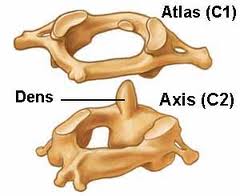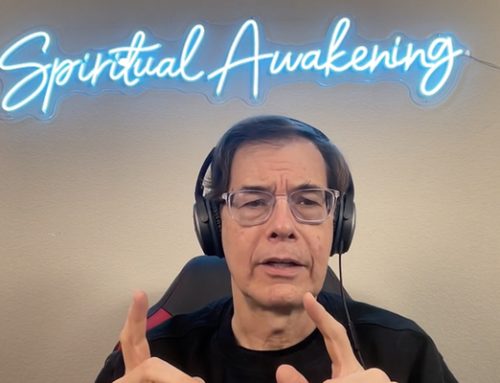Good Thursday to You!
My day was chalk-a-block as the Australians would say.
I managed to sneak in an intensive 20 minute pushing session. I coupled bilateral cable pushes with single arm action with Swiss ball dumbbell bench pressing. I did four mini-circuits and that was enough to keep in the game of youthfulness.
CHEK TOTEM POLE PART 6: THE UPPER CERVICAL SPINE

The fifth symbol from the top of the Chek Totem Pole (CTP) you see above represents the upper cervical spine.
The upper cervical spine (UCS) is an important part of our anatomy that is unfortunately, poorly understood by even the most skilled rehabilitation and medical professionals at large.
The upper cervical spine is composed of:
A. The occiput or base of the skull, which rides atop of,
B. The atlas, or top cervical vertebra, and
C. The axis, or second cervical vertebra; the axis creates a post of bone that acts as an axis or axle that the atlas and skull rotates around when you turn your head.
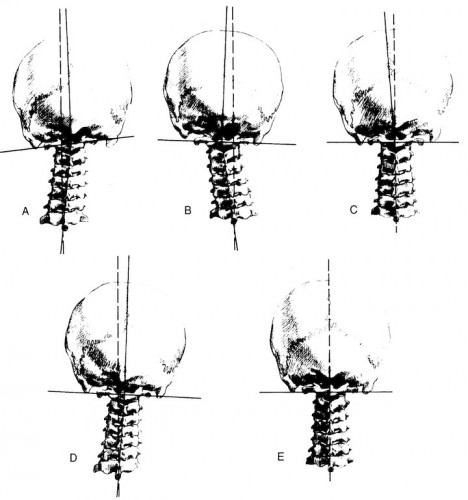
The atlas is the most unstable of all spinal vertebra. Fifty percent of your capacity to rotate your head and neck comes from the atlas rotating around the atlas.
The chief problem with any atlas subluxation (mal position) is that it attaches to, and can distort the spinal cord, causing body-wide problems. Every nerve in your body passes through the atlas.
Therefore, any upper cervical problem that causes adverse mechanical tension in the spinal cord or central nervous system can produce problems and symptoms literally anywhere in your body and in any system of your body!
The National Upper Cervical Chiropractic Association (NUCCA) has mapped over 10,000 patterns of atlas subluxation on x-ray analysis. They have broken them down into for classic subluxation types or patterns, which are shown as A, B, C and D above, with E representing normal alignment.

In the image above, you can see the normally aligned spin and body (A). To the right (B), you can see that when an atlas subluxation occurs, there is commonly a functional scoliosis (spinal S curvature) and leg length discrepancy created.
This occurs largely because the body will make any attempt necessary to keep the eyes, ears and teeth horizontal, or perpendicular to the surface of the earth; we must maintain horizontal ear, eye and teeth relationships for reasons of essential structural balance and to see what may eat us, and what we may want to eat/hunt on the horizon.
Dr. Glen Cripe, DC’s research showed that approximately 98% of the time, there is a weight shift of 5 pounds or greater to the side the atlas has rotated or translated toward. This can easily be seen when using two calibrated scales to measure a patient’s weight shift.
CHEK Practitioners are taught how to identify atlas subluxation patterns early in their training so they know when to refer out to specialists to make an atlas/axis (upper cervical) correction.
I teach CHEK Level 3 Practitioners how to use specific stretching and muscle activation techniques to realign the entire head, neck and jaw complex.
Though the methods I teach do work effectively, there are often complex patterns of upper cervical subluxation that need a comprehensive x-ray analysis and the highly specific upper cervical correction that can only be performed by a NUCCA Chiropractor or physician with similar training.
Of all the NUCCA doctors I’ve worked with, Dr. Kenny Sheppard in Solana Beach, CA., has produced the most consistent long-term corrections. His office can be reached at: 858-481-3793.
I’ve had many elite athletes fly around the world to see him, and all have been happy they did!
ATLAS FACTS YOU ALL NEED TO KNOW ABOUT!
There are several key facts about atlas subluxation everyone should know about for their own health and well-being:
1. Visual Distortion: Any atlas subluxation is likely to disrupt the balance of your ocular (eye) muscles. Over time, this can, and commonly does create visual problems.
Any use of surgical correction of vision before restoring atlas and overall spinal alignment can, and often does create long-term problems!
For example, I’ve had several clients that developed visual problems and resorted to surgical correction before getting their atlas corrected and spinal alignment (posture) restored.
Once I corrected their atlas subluxation and spinal alignment, they developed new visual problems and often experienced significant headaches.
This occurs because the eye/lens correction now holds the eye in a dysfunctional position relative to normal/optimal structural alignment.
The key issue to always remember here is that any surgical correction of eyes that takes place before spinal alignment is restored is a formula for chronic health challenges!
2. Bite Distortion: The atlas complex is intimate with the jaw and cranium (head) at large. Any change in the position of the atlas/axis complex results in changes in the bite; the way your teeth fit together.
If you have an atlas subluxation or spinal alignment problem and a dentist or orthodontist grinds your teeth, or used orthotic devices to correct your bite, you will experience pain and problems when your structure is corrected!
Because “bite” or occlusion ranks higher on the CTP than the upper cervical spine, the body will typically not hold spinal or postural corrections.
It will compensate in any region of the body necessary to restore optimal bite because you only get one set of adult teeth and when they wear out, you would have died in your natural developmental environment (nature).
When people keep seeing therapists for structural correction after teeth have been calibrated with a crooked body, the corrections they make throw the bite off, creating compensatory stress on the body.
This often leads to trigger points in muscles, poor coordination of the mouth muscles resulting in tongue biting, cheek biting, swallowing difficulties, and headaches.
These compensatory problems can, and often do cause a person’s balance to be deteriorated, making falling more likely among athletes, elderly people, and everyone else.
3. Anything Is Possible!: When the atlas complex is not functioning correctly, every nerve passing from the brain into the body is at risk of both excessive compression, or excessive tension.
Having studied atlas subluxation complex challenges since 1988, I’ve seen almost every kind of symptom emerge, and clear in direct response to challenges with the upper cervical spine.
For example, I’ve seen females who’ve not menstruated for years begin to menstruate within minutes or hours after atlas/axis correction. I’ve seen chronic constipation clear, beginning within as little as one minute after atlas correction.
I’ve seen problems with almost every organ clear or improve very quickly after atlas corrections. I’ve seen chronic back pain, neck pain, and most any pain in the structure you can think of disappear within minutes of an accurate upper cervical correction.
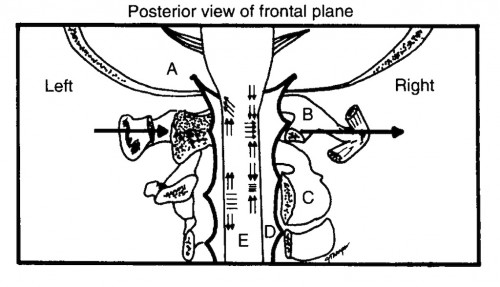
Research by the NUCCA demonstrated that the average lateral translation with an atlas/axis subluxation is 3mm. In my diagram above, you can see a drawing I created to explain what occurs when a lateral translation (or rotational subluxation) occurs.
In my diagram above:
A. Represents the skull or occiput and the dark lines running from there to the spinal cord represent the denticulate ligaments. The denticulate ligaments suspend the spinal cord in the spinal column to support and protect it from unwanted shock, compression, tension or torsion, all of which can distort nerve conduction.
B. Represents the atlas in right translation.
C. Represents the axis in compensation.
D. Represents further stress on the denticulate ligaments.
E. Represents the spinal cord.
Here are a few facts you should all understand:
1. The average human spinal cord is 12mm in diameter. An average lateral subluxation of the atlas being 3mm is 25% of the diameter of the spinal cord.
This is easily enough distortion to create impairment of neurological conduction and a host of confusing problems that physicians often treat with drugs and surgery, to no avail!
2. The arrows in the spinal cord (E) represent compression, angular tension, and compression patterns common with atlas subluxations.
Alf Brieg, a famous Swedish Neurosurgeon (See Adverse Mechanical Tension In The Central Nervous System by Alf Brieg) showed in his research that slight compression can excite nerve conduction, causing end organs to speed up or become overly excited.
Increased compression, or tension typically causes a loss of nerve conduction, resulting in a wide variety of functions (such as digestion and elimination) to be slowed down.
3. Because the upper cervical complex is so high on the CTP, unresolved problems at this level can, and frequently do cause people to not be able to heal from acute or chronic musculoskeletal injuries.
Any subsystem that is subordinate to any higher system in the CTP will be sacrificed in compensation to keep more essential survival systems on line.
This can result, for example, in someone ending up wearing their hip, knee or lumbar spinal joints out after years of attempted therapy to reduce pain in these areas because such issues can’t be resolved as long as they are compensations for higher-order systems!
4. BACK PAIN IS OFTEN YOUR FIRST INDICATOR OF ATLAS/AXIS SUBLUXATION!
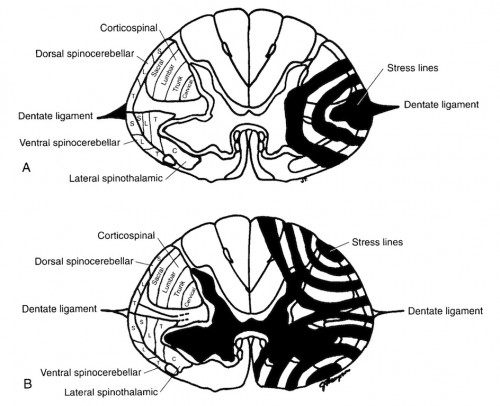
In my drawing above, you can see the spinal cord transected at the level of the atlas (C1). Please note where the denticulate ligaments attach on either side of the cord while keeping in mind that these ligaments also attach to the body of the atlas and in some people, to the body of the axis as well.
Next, notice that the cord tracts for the dorsal (back) and ventral (front) spinocerebellar system (spinal information being sent to the cerebellum; part of your brain that is highly involved in all aspects of coordinating movement) are directly beneath the dentate ligaments.
Note also, that the stress lines I’ve drawn depict that the stress of abnormal nerve tension can and does often reach into the corticospinal tract (Brain to spine information about movement).
Next, please notice that the areas of these cord tracts that control your sacral and lumbar spinal regions are the first to be distorted by upper cervical subluxation.
The result then, is that most people with upper cervical subluxation patterns complain of back pain, and often don’t notice or feel anything wrong with their neck at all!
Part of this has to do with the fact that the neck carries very little weight relative to the lumbar and sacral regions of the spine.
Therefore, the compensatory stress takes longer to manifest as pain than it does in the lumbar and pelvic regions that are constantly under significant load.
The number of people seeking help for back pain that is either a direct result of upper cervical imbalances or won’t heal because of them is too vast for me to even begin to calculate! It’s likely to be in the multiple millions!
Note also that the distortion patterns can, and do reach the lateral spinolthalamic tract, which is responsible for handling such neurological experiences as pain, temperature regulation, and light touch sensation.
It is also common for people with upper cervical subluxations to have strange combinations of pain, tingling, numbness, and a host of other regulatory problems, including any and all autonomic functions being distorted.
WHAT TO DO?
As I mentioned earlier in the blog today, All CHEK Level 3 and 4 Practitioners are trained in highly specific assessments for the upper cervical spine.
They are also taught to know when their gentle stretching and muscle activation methods are not effective enough to make a long-term correction so they know when to refer out to NUCCA or related specialist physicians that can make an effective correction, for which there are sadly, very few.
If after reading this blog you are saying to yourself, “wow, that sounds a lot like me!”, then you would be best served to go to www.chekconnect.com and search in our locator function for a CHEK Level 3 or 4 Practitioner nearest to you.
You may also want to consider flying to San Diego and seeing Dr. Kenny Sheppard.
I have kept this discussion brief and quite simplistic because my blog is intended to be an information source for the public, not just the professionals.
For those of you wanting a more comprehensive explanation of the atlas subluxation complex, or other aspects of posture and craniofacial pain, you can purchase a chapter I wrote for a medical book that is now out of print.
My chapter is titled, Posture and Craniofacial Pain. Be warned though, this chapter is written for the professional medical community and it is loaded with $10 words, so have a good medical dictionary handy.
I hope you’ve enjoyed a review of the upper cervical section of the CTP today.
May you learn to love and care for your body with joy and wisdom.
Love and chi,
Paul Chek
